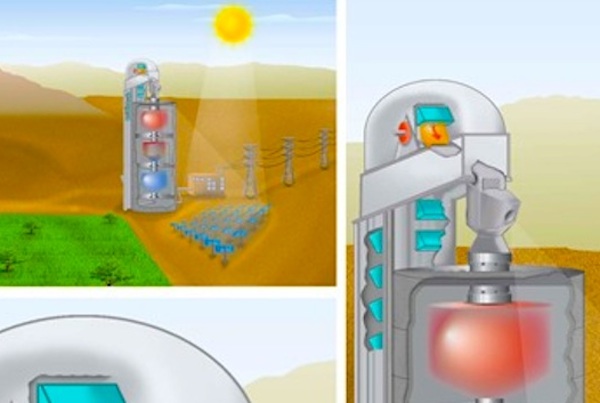
 Falling-particle receivers may one day convert solar energy to electricity in large-scale, concentrating solar power plants, Sandia researchers say. (Credit: R. Montoya/Sandia.)
Falling-particle receivers may one day convert solar energy to electricity in large-scale, concentrating solar power plants, Sandia researchers say. (Credit: R. Montoya/Sandia.)
“Like sands through the hourglass…so go the days of our lives.”
That line—the opening of long-running TV soap opera “Days of Our Lives”—might be familiar to readers of a certain age. For younger readers, it may help to at least have an idea of what a soap opera is.
What brought the lead-in to a sappy TV show to mind? This news release from Sandia National Laboratories, Albuquerque, N.M., which describes the lab’s efforts to develop a falling-particle receiver to harness solar power. Working with researchers from Georgia Tech, Bucknell University, King Saud University, and the Institute for Solar Research of the German Aerospace Center, Sandia scientists are trying to resurrect a solar energy technology that dates to the 1980s.
Falling particle solar involves allowing sand-like ceramic particles to fall from the top of a receiver tower past a focused beam of sunlight from an array of solar concentrators, according to a previous Sandia release on the technology. The concentrated solar energy heats the particles to several hundred degrees Celsius. Heated particles are then stored in the topmost of a series of three tanks until energy is needed, at which point they are released to a middle tank where their heat is extracted. Cooled particles then drop to the lowest tank and are cycled back to the top of the tower to restart the process.
Issues with previous generations of falling-particle solar apparatuses have included particle loss, stability of the falling particles, particle residence time in the concentrated solar beam, and heat losses within the receiver cavity, the current release says. Sandia engineer Cliff Ho and colleagues are attempting to mitigate these shortcomings by working to optimize particle size and heating as the particles fall through the concentrated solar beam and using blowers to create an air curtain that cuts particle loss. They also are investigating the potential benefits of using an elevator to recirculate particles through the beam a second time to increase their temperature before storage.
The researchers are making use of process simulation as well as Sandia’s National Solar Thermal Test Facility to develop prototype hardware for the project. They expect the innovations to yield efficiencies of 50 percent or more, Ho says.
“Our goal is to develop a prototype falling particle receiver to demonstrate the potential for greater than 90 percent thermal efficiency, achieve particle temperatures of at least 700°C, and be cost competitive,” he says in the release. “The combination of these factors would dramatically improve the system performance and lower the cost of energy storage for large-scale electricity production.”
According to the release, Sandia hopes the research leads to “power tower” falling particle systems with up to 100 MW capacity. Funded by the US Department of Energy’s SunShot Initiative, the project is expected to yield a test-ready design in 2015.
